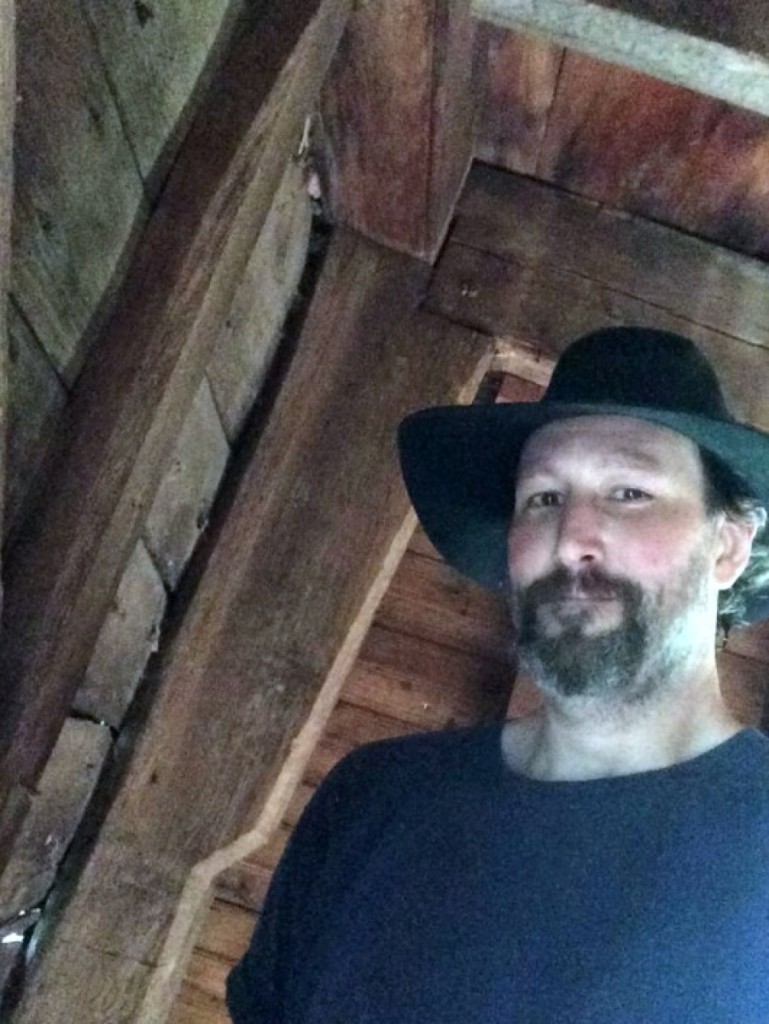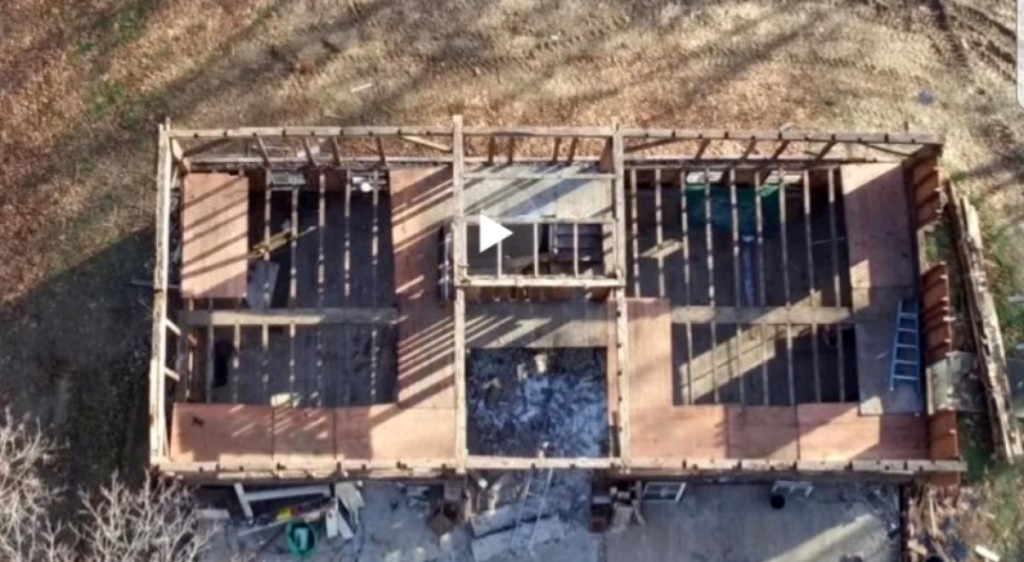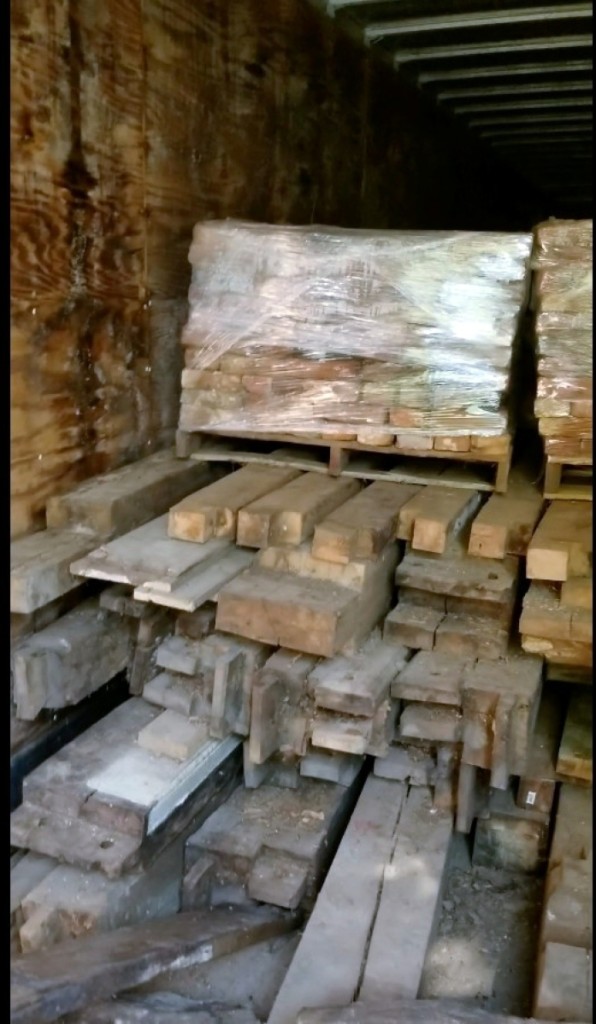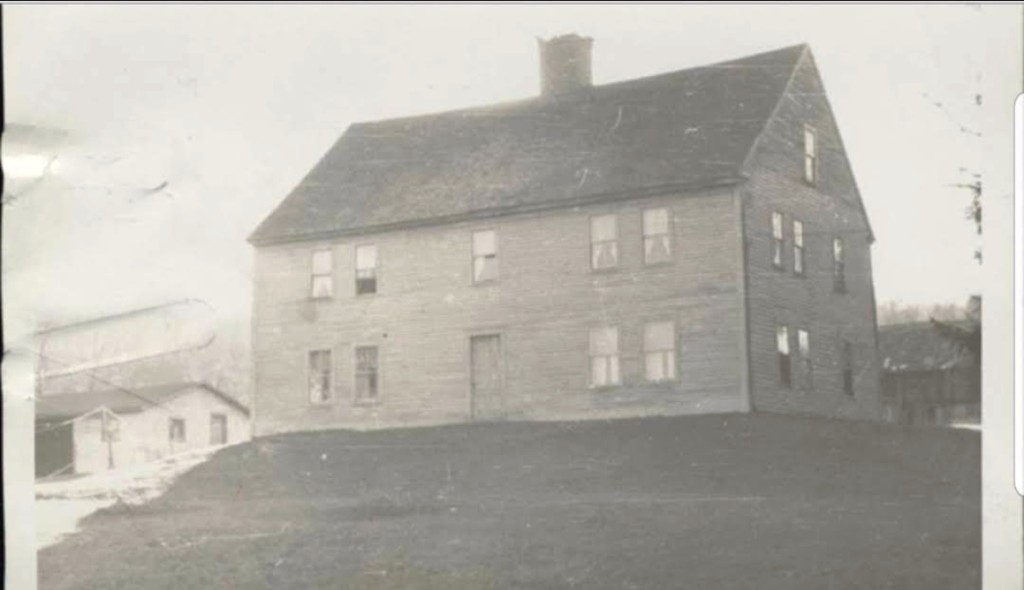
Young standing in the front corner of the house he has disassembled. Behind him is a gunstock or jowel post, suggesting a possible Seventeenth Century construction date.
Andrew Young is a craftsman and restorer of antiques and historical structures near Washington DC. His family history, which goes back to Seventeenth Century America, contributed to a lifelong wish to live in a Seventeenth Century house. He found one in Connecticut that could not be saved locally, but which he dismantled and is in the process of relocating to the DC area. Young takes the long view that more historic properties could be preserved for posterity if they were dismantled, moved and rebuilt – either in the same location or elsewhere – a process that might seem unusual to many. Antiques and the Arts Weekly caught up with this budding movement leader to learn more about what is involved and why this option may be a viable alternative to the wrecking ball.
What did you know about your house before you dismantled it, and what did that process discover?
Until that house is dismantled or you have a dendrochronology or core sample test of the large beams, the age and history of ownership is often questionable. Houses were often rebuilt, renovated and composed of parts of former houses, adding confusion – some were even dismantled and moved back then! Modest rural houses tended to lag behind urban homes in style. Our house has plenty of formerly used components that adds to the rich story. In disassembling, we discovered Seventeenth Century construction details, despite having been partially covered in Eighteenth Century planks. We discovered shoes in the chimney, and carved symbols for spiritual protection. Dismantling peeled back 300-plus years. Very exciting!
What are your plans for it and what is your timeline for that?
I’d love to partner with a filmmaker to shoot a series or documentary. I have 30 years’ experience giving live presentations, hosting and acting…and of course I have a great set to film on as well as many other locations that have invited me to film. It’s really exciting history and “HGTV-type” stuff. Generations of younger people and immigrants do not know what old American architecture, culture or technology even looked like because so many of these places are being torn down. Ultimately, I want to rescue other endangered houses and barns up and down the coast and create an education-focused site.
Where are you in the process?
I’m about to open up the trailers and pull out the frame and begin restoration. The University of Connecticut is set to come out this spring to continue digs on the original land. I will probably be restoring an 1830 log cabin to live in while I work on the main house. I’m always researching something or trying to learn a new skill.
You have become a passionate advocate for dismantling historic properties instead of destroying them. What prompted that?
Each month, yet another 100-, 200- or 300-year-old house or barn is torn down! Our country is not that old, and we do not have an unlimited supply of these old places. I view dismantling and moving these places to another location as the lesser of two evils. In some ways, it’s akin to realizing the huge loss of trees and forests since suburban sprawl. I find the destruction of historical buildings or nature to be an absolute failure of true human ingenuity – learning to live and work around existing structures forces us to be even more creative, spurring real genius. I’m no Luddite, but time and money has blinded us to believe we can’t live with the past in order to progress – it’s just silly. The sheer number of historical buildings lost each month is a serious cultural amputation and it erodes crucial tourism dollars too! Seriously, show me a couple (perhaps with their kids on a Sunday drive or vacation) that is eager to drive through a landscape of cold industrial steel and concrete buildings? When we have mentioned the loss of tourism dollars, agro-tourism etc – many local councils seem awestruck when this is mentioned…as if, “oh yeah, good point.”
Do you have any statistics for the rate at which we are losing historic buildings?
In many cases, houses and barns are demolished without any authentic public warning – purposefully. This is often the case in rural areas where oversight doesn’t exist, or tourism dollars are not recognized yet. Many of my elders in this field speak of the 1960s urban renewal as being the first massive loss. Overall, barns, log cabins and houses in rough or rural areas are being lost at the highest rate. Based on news articles, sales of timber frames cut up for lumber, local citizen reports and anecdotal evidence, we lose approximately ten structures built before 1860 each month. Do the math…in ten years, that’s about 1,200 destroyed structures. In 50 years, more than 6,000 historic houses and barns. It’s obscene. It does not take much for a house or barn to fall on hard times: poor economy, health or death in the family, a changing area. A big part of the problem is the prim or rustic look in decorating…people like old beams inside their clean suburban interiors…except that they don’t realize their decor flavor is feeding the destruction of barns and houses, which are cut up for sale. Sometimes landowners can’t afford upkeep or taxes. Rather than dismantle and rebuild it, there are parasitic entrepreneurs (I’m being polite) who are eager to cut up these old buildings, regardless of the cultural loss, and turn them into flooring or mantelpieces. They argue that the barn or house was too rotted to be saved, then they mysteriously turn around and sell thousands of board feet of planks they cut from that mysteriously rotted up barn. Curious eh? Cutting up these feats of engineering and history is a nonrenewable resource. Once gone, they are gone forever.
Other than the obvious advantage of saving vs losing something, what are other advantages most people might not know about or understand?
They are far better built than new houses and many buildings. Old barns and houses with huge beams can be converted to incredibly strong homes, businesses and restaurants. Colonists coming from timber-short Europe realized a seemingly endless number of trees, so they over-engineered their houses and barns – which is why many have survived hurricanes and tornadoes where modern buildings blow away! The other issue is respect for our cultural and historical fabric. Imagine we trashed the pyramids so easily….ground up the stone for driveway pebbles. Most people realize that the pyramids were feats of amazing engineering. Well, so were those old houses.

Screen shot from a video showing a bird’s-eye view of the second floor of the house during deconstruction.
One might think dismantling and rebuilding would be MORE costly and/or time consuming than destroying and building over…is that wrong, and why?
Dismantling and rebuilding involve phases. Those phases can be useful in recouping funds. Dismantling a house and putting them into trailers usually runs around $30-40,000, plus the structure’s cost, which is usually similar. So, for an average of around $55-70,000, a house can be purchased, dismantled and stored. I waited a few years to recoup my costs, saved up for land and rebuilding. Costs can be cut if the homeowner researches and learns various basic skills that they can do as weekend projects. I meet many people who lack confidence about doing the work themselves, until I work with them, teaching them. I’m self-taught. Anyone can learn with the right attitude.
What’s the average process, start to finish, of dismantling?
It starts with taking lots of photographs of the structure from lots of different angles, even odd nuanced angles, and damage, which you’ll need to reference later on. It’s much easier to restore damaged parts when the structure is dismantled. Next, measure the structure, as if creating blueprints. Then the physical disassembling begins. Doors, windows, wall panels, flooring come out. The plaster walls are taken out to expose the frame. Sometimes cranes are needed to lift the heavy beams up and out. You must have trailers onsite, ready to be filled. In many cases, a contractor and permit are needed for dismantling.
That sounds more extensive than a DIY project…are there sufficient carpenters around who are trained in doing this who can responsibly tackle such projects?
I have a large and growing social media group on historical building and timber framing. We have many pros and experts in historical building and traditional building techniques that can help. Anyone is welcome to join or contact me.
Is there a downside to dismantling a house or barn?
The loss of its original location, especially if no archeological digs are attempted. Original plaster is hard to save. Sometimes coming up with big sums of money can be tough. When I started, I worked 15-hour days, 7 days a week and sold my antiques on Craigslist to fund the project!

Once diassembled, the timbers of the house frame were stacked inside a trailer until the house can be reassembled.
Do you think more old structures should be saved and moved?
Crucial answer – only those in danger of demolition or severe decay. For 25 years, my house was in slow decay. The entire bottom frame and floor had rotted away. Animals wandered the house. Mold, rot and animal feces abounded. Still, I do believe the local community should have the right to vote on a structure’s realistic future. If the town can muster funds to restore it, or move it nearby, citizens should have that right to vote on various options.
What can people do if they want to support this movement?
Ultimately, we need to phase in business-friendly, protective laws, similar to other countries that have preserved history for their future generations, aided by billions of tourism dollars, and still live and work in those buildings. We should enjoy and live with these buildings, not destroy our historical fabric. Once gone, they are gone forever.
Until then….Be extremely proactive! I can’t emphasize that enough. Form a group of citizens who have three concurrent goals:
First: Be constantly attuned to the pipeline of real estate sales, foreclosures, upcoming construction/developer projects or demolition. Much of that is public info. Drive around and talk to owners of houses or barns that seem to be struggling or in rough areas. Are they thinking of selling? Work with these people, not against them. Many construction companies do not want to demolish old houses if they can avoid it. Ask them to help you with things like asbestos or lead abatement costs if it’s an obstacle.
Second: Contact both media and local county, state and federal political representatives. Pester them to take this problem seriously but also that dismantling and moving a structure is an affordable and viable way to save that building.
Lastly: Raise money BEFORE dismantling is needed. Get creative with fundraising. Start a Facebook group, or an online fundraising campaign. Don’t worry about raising it all at once. Sell T-shirts, aprons, mugs, cookies, go door to door talking to locals and asking for money. Look for big donors, local or former celebrities and local businesses to contribute funds. Whatever it takes! Talk to the IRS about a nonprofit status. Some rental places will waive equipment fees or portable bathrooms for dismantling jobs. Restaurants might kick in lunches for dismantling crews. Aim to raise amounts in the $30,000 range, because that is the average cost of moving a house or barn. Sooner or later, that money will be needed to dismantle and save a house or barn near you. The key here is to raise money BEFORE a structure is endangered. It can be tough to convince people at first that there is a danger of loss, but you have to try.
I am happy to address questions, offer guidance or help.
Editor’s note: For more information or to contact Young, www.historymovers.org or www.chesapeakeartistry.com. Follow his Facebook blog: “Olde New England Dreams: A First Period, Colonial House Project“
-Madelia Hickman Ring





